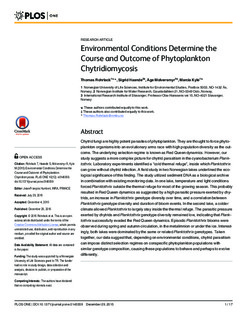Environmental Conditions Determine the Course and Outcome of Phytoplankton Chytridiomycosis
Journal article
Permanent lenke
http://hdl.handle.net/11250/2375606Utgivelsesdato
2015Metadata
Vis full innførselSamlinger
- Publikasjoner fra Cristin - NIVA [2149]
- Scientific publications [1172]
Sammendrag
Chytrid fungi are highly potent parasites of phytoplankton. They are thought to force phytoplankton organisms into an evolutionary arms race with high population diversity as the outcome. The underlying selection regime is known as Red Queen dynamics. However, our study suggests a more complex picture for chytrid parasitism in the yanobacterium Planktothrix. Laboratory experiments identified a “cold thermal refuge”, inside which Planktothrix
can grow without chytrid infection. A field study in two Norwegian lakes underlined the ecological significance of this finding. The study utilized sediment DNA as a biological archive in combination with existing monitoring data. In one lake, temperature and light conditions forced Planktothrix outside the thermal refuge for most of the growing season. This probably resulted in Red Queen dynamics as suggested by a high parasitic pressure exerted by chytrids, an increase in Planktothrix genotype diversity over time, and a correlation between Planktothrix genotype diversity and duration of bloom events. In the second lake, a colder climate allowed Planktothrix to largely stay inside the thermal refuge. The parasitic pressure exerted by chytrids and Planktothrix genotype diversity remained low, indicating that Planktothrix successfully evaded the Red Queen dynamics. Episodic Planktothrix blooms were observed during spring and autumn circulation, in the metalimnion or under the ice. Interestingly, both lakes were dominated by the same or related Planktothrix genotypes. Taken together, our data suggest that, depending on environmental conditions, chytrid parasitism can impose distinct selection regimes on conspecific phytoplankton populations with similar genotype composition, causing these populations to behave and perhaps to evolve differently.
Beskrivelse
-

